LITNET is Lithuanian Research and Education Network in Lithuania. It was established in 1991 and had X.25 satellite connectivity to University of Oslo.
LITNET NOC is located in Kaunas University of Technology (KTU).
LITNET is Lithuanian Research and Education Network in Lithuania. It was established in 1991 and had X.25 satellite connectivity to University of Oslo.
LITNET NOC is located in Kaunas University of Technology (KTU).

Belarus, officially the Republic of Belarus, and historically Byelorussia, is a landlocked country in Eastern Europe. It is bordered by Russia to the east and northeast, Ukraine to the south, Poland to the west, and Lithuania and Latvia to the northwest. Covering an area of 207,600 square kilometres (80,200 sq mi) and with a population of 9.3 million, Belarus is the thirteenth-largest and the twentieth-most populous country in Europe. The country is administratively divided into seven regions. Minsk is the capital and largest city.

Lithuania, officially the Republic of Lithuania, is a country in the Baltic region of Europe. It is one of three Baltic states and lies on the eastern shore of the Baltic Sea. Lithuania shares land borders with Latvia to the north, Belarus to the east and south, Poland to the south, and Kaliningrad Oblast of Russia to the southwest. Lithuania covers an area of 65,300 km2 (25,200 sq mi), with a population of 2.8 million. Its capital and largest city is Vilnius; other major cities are Kaunas and Klaipėda. Lithuanians belong to the ethno-linguistic group of the Balts and speak Lithuanian, one of only a few living Baltic languages.
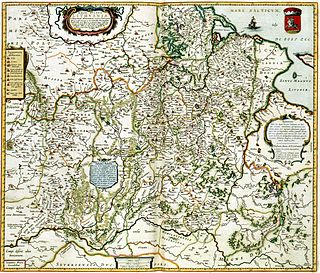
The history of Lithuania dates back to settlements founded many thousands of years ago, but the first written record of the name for the country dates back to 1009 AD. Lithuanians, one of the Baltic peoples, later conquered neighboring lands and established the Grand Duchy of Lithuania in the 13th century. The Grand Duchy was a successful and lasting warrior state. It remained fiercely independent and was one of the last areas of Europe to adopt Christianity. A formidable power, it became the largest state in Europe in the 15th century through the conquest of large groups of East Slavs who resided in Ruthenia. In 1385, the Grand Duchy formed a dynastic union with Poland through the Union of Krewo. Later, the Union of Lublin (1569) created the Polish–Lithuanian Commonwealth that lasted until 1795, when the last of the Partitions of Poland erased both Lithuania and Poland from the political map. After the dissolution, Lithuanians lived under the rule of the Russian Empire until the 20th century, although the were several major rebellions, especially in 1830–1831 and 1863.
This article provides an overview of telecommunications in Lithuania, including radio, television, telephones, and the Internet.
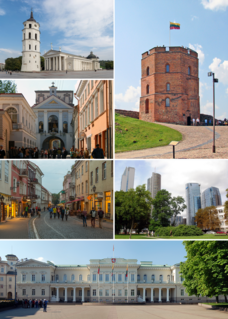
Vilnius is the capital and largest city of Lithuania, with a population of 588,412 as of 2021. The population of Vilnius's functional urban area, which stretches beyond the city limits, is estimated at 706,832, while according to the Vilnius territorial health insurance fund, there were 732,421 permanent inhabitants as of October 2020 in Vilnius city and Vilnius district municipalities combined. Vilnius is in southeastern Lithuania and is the second-largest city in the Baltic states. It is the seat of Lithuania's national government and the Vilnius District Municipality.
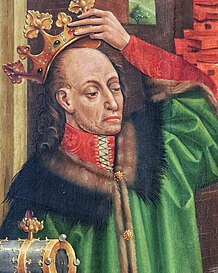
Jogaila, later Władysław II Jagiełło was Grand Duke of Lithuania (1377–1434) and then King of Poland (1386–1434), first alongside his wife Jadwiga until 1399, and then sole ruler of Poland. He ruled in Lithuania from 1377. Born a pagan, in 1386 he converted to Catholicism and was baptized as Władysław in Kraków, married the young Queen Jadwiga, and was crowned King of Poland as Władysław II Jagiełło. In 1387 he converted Lithuania to Christianity. His own reign in Poland started in 1399, upon the death of Queen Jadwiga, lasted a further thirty-five years, and laid the foundation for the centuries-long Polish–Lithuanian union. He was a member of the Jagiellonian dynasty in Poland that bears his name and was previously also known as the Gediminid dynasty in the Grand Duchy of Lithuania. The dynasty ruled both states until 1572, and became one of the most influential dynasties in late medieval and early modern Europe. During his reign, the Polish-Lithuanian state was the largest state in the Christian world.
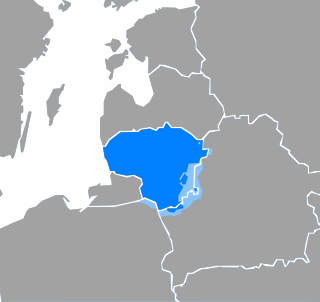
Lithuanian is a Baltic language belonging to the Balto-Slavic branch of the Indo-European language family. It is the official language of Lithuania and one of the official languages of the European Union. There are about 2.8 million native Lithuanian speakers in Lithuania and about 200,000 speakers elsewhere.

Klaipėda is a city in Lithuania on the Baltic Sea coast. The capital of the eponymous county, it is the third largest city and the only major seaport in Lithuania.

Kaunas is the second-largest city in Lithuania after Vilnius and an important centre of Lithuanian economic, academic, and cultural life. Kaunas was the biggest city and the centre of a county in the Duchy of Trakai of the Grand Duchy of Lithuania and Trakai Palatinate since 1413. In the Russian Empire, it was the capital of the Kaunas Governorate from 1843 to 1915.

The Baltic states or the Baltic countries, also known as the Baltic nations, and less often as the "Baltic republics", the "Baltic lands", or simply the Baltics, is a modern unofficial geopolitical term, typically used to group three sovereign states on the eastern coast of the Baltic Sea: Estonia, Latvia, and Lithuania. The term is not used in the context of cultural areas, national identity, or language, because while the majority of people in Latvia and Lithuania are Baltic people, the majority in Estonia are Finnic. The three governments engage in intergovernmental and parliamentary cooperation. There is frequent cooperation in foreign and security policy, defence, energy, and transportation.

Norsk Data was a minicomputer manufacturer located in Oslo, Norway. Existing from 1967 to 1998, it had its most active period from the early 1970s to the late 1980s. At the company's peak in 1987 it was the second largest company in Norway and employed over 4,500 people.

The Polish–Lithuanian Commonwealth, formally known as the Kingdom of Poland and the Grand Duchy of Lithuania, and, after 1791, the Commonwealth of Poland, was a country and bi-federation of Poland and Lithuania ruled by a common monarch in real union, who was both King of Poland and Grand Duke of Lithuania. It was one of the largest and most populous countries of 16th to 17th-century Europe. At its largest territorial extent, in the early 17th century, the Commonwealth covered almost 1,000,000 square kilometres (400,000 sq mi) and as of 1618 sustained a multi-ethnic population of almost 12 million. Polish and Latin were the two co-official languages.

The Grand Duchy of Lithuania was a European state that lasted from the 13th century to 1795, when the territory was partitioned among the Russian Empire, the Kingdom of Prussia, and the Habsburg Empire of Austria. The state was founded by Lithuanians, who were at the time a polytheistic nation born from several united Baltic tribes from Aukštaitija.

Valdas Adamkus is a Lithuanian-American politician, diplomat and civil engineer. He served as the 5th and 7th President of Lithuania from 1998 to 2003 and again from 2004 to 2009.

Vilnius University is a public research university, which is the oldest university in the Baltic states, and one of the oldest and most famous in Northern Europe. Today it is Lithuania’s leading academic institution, ranked among the top 400 universities worldwide (QS).
Lithuanian mythology is the mythology of Lithuanian polytheism, the religion of pre-Christian Lithuanians. Like other Indo-Europeans, ancient Lithuanians maintained a polytheistic mythology and religious structure. In pre-Christian Lithuania, mythology was a part of polytheistic religion; after Christianisation mythology survived mostly in folklore, customs and festive rituals. Lithuanian mythology is very close to the mythology of other Baltic nations – Prussians, Latvians, and is considered a part of Baltic mythology.
A national research and education network (NREN) is a specialised internet service provider dedicated to supporting the needs of the research and education communities within a country.

Born in Phalaborwa, South Africa on 28 September 1971, Anton Robert Krueger is a South African playwright, poet and academic. His plays have been staged in South Africa, as well as in England, Wales, Australia, the USA, Monaco, Venezuela, Argentina and Chile. He has published under the pseudonyms of Martin de Porres, Robert Krueger, A.R. Krueger, Perd Booysen and Sybrand Baard.

Stacy M. Hardy is a writer, journalist, multimedia artist and theatre practitioner. She is a founding member of the Venus Fly Trapeze Theatre Company, which has produced 8 original productions since 1995. She has lectured and tutored in the Drama Department at Rhodes University (1996–98) and remains active in using theatre as an educational tool by lecturing and hosting workshops for the Grahamstown Foundation's National Schools Festival (1996–2003). She is currently scripting a new play for acclaimed South African director Jaco Bouwer.
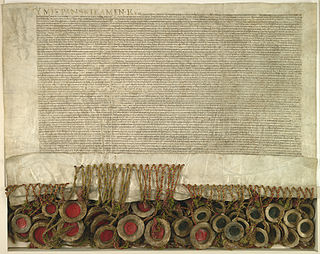
The Union of Lublin was signed on 1 July 1569 in Lublin, Poland, and created a single state, the Polish–Lithuanian Commonwealth, one of the largest countries in Europe at the time. It replaced the personal union of the Crown of the Kingdom of Poland and the Grand Duchy of Lithuania with a real union and an elective monarchy, since Sigismund II Augustus, the last of the Jagiellons, remained childless after three marriages. In addition, the autonomy of Royal Prussia was largely abandoned. The Duchy of Livonia, tied to Lithuania in real union since the Union of Grodno (1566), became a Polish–Lithuanian condominium.